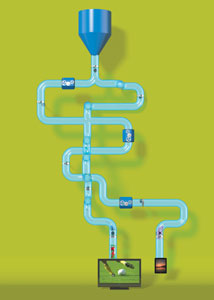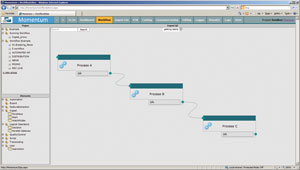Supporting TV Everywhere
The fantastic increase in online and mobile content consumption, in addition to traditional TV viewing, is driving a greater number and variety of media companies to take on the challenge of multiplatform content creation and delivery to outlets such as Netflix and iTunes. Traditional broadcast workflows do not economically scale to address the demands of this new delivery model, which requires processing and management of a much greater volume of content and metadata, as well as the ability to address the different format requirements associated with each consumption platform.

A sophisticated and automated media workflow is required to meet the demands of TV Everywhere.
As a result of this shift, media businesses are considering new workflows and new approaches in managing them. Among these approaches has been the extension of automation back up the media supply chain, from its conventional role in master control into content production processes. This article will examine this changing role of automation, the more complicated workflows it now supports, fundamental considerations in implementing a more comprehensive process automation, and finally, the added business benefits that can be derived by using automation to facilitate efficient multiplatform content creation and delivery.
Broadening the scope of automation
The recent focus on broadcast automation has been directed primarily toward the introduction of IT-based technologies and the commercial and operational savings they bring. The demands of “TV Everywhere,” however, present a second dynamic that is fundamentally redefining what we understand by the term “automation.” To help media businesses maximize their resources and meet the demands of TV Everywhere cost-effectively, automation as we have known it — providing real-time, frame-accurate control over servers, switchers, graphics devices and such — is now extending outside of the master control environment to enable more sophisticated automation of media workflows throughout the entire broadcast operation.
Workflow has been a buzzword in the file-based domain for a number of years, and many of the solutions in this area have targeted the movement of digitized assets. The preparation and delivery of content to multiple platforms, however, demands greater workflow sophistication because it brings into play the manipulation and analysis of these digital media assets and their associated metadata through a combination of manual and automated processes. Responding to the significant rise in workflow complexity in a hybrid (manual/automated) environment, automation vendors are offering a new generation of solutions with much greater utility in facilitating the handling, performance and tracking of upstream processes.

Figure 1. Shown here is the uncomplicated flow of media in the unusual case that no variations in processing are required, and not a single issue arises as this processing is performed.
The professional video industry's #1 source for news, trends and product and tech information. Sign up below.
Addressing workflow complexity
Workflow, in its simplest form, is easy to comprehend. It is a sequence of tasks or operations performed on a piece of media. In the management of multiplatform content creation and delivery, however, a simple and linear A-to-B-to-C sequence is rarely sufficient. Figure 1 demonstrates the uncomplicated flow of media in the unusual case that no variations in processing are required, and not a single issue arises as this processing is performed.
Figure 2 illustrates a more realistic flow in which key manual and automated processes — ranging from quality control to format checking to closed-captions validation — depend on one another and often link back on themselves. With all of these possibilities, real-world workflows need to be implemented with conditional logic that allows downstream operations to be determined by the results of upstream operations, or by the metadata associated with an asset. Multiple paths, various points of entry and exit, and differing final outcomes all are a given.

Figure 2. Shown here is a realistic workflow in which key manual and automated processes depend on one another and often link back on themselves.
The accurate documentation of an operation’s current workflows, including manual and automated tasks, is a good starting point in designing and implementing an optimized workflow solution. The effort pays dividends by helping not only to identify a more streamlined flow of content from beginning to end, but also to highlight areas in which greater efficiencies could be realized with the aid of greater automation. Ideally, this information frees the business to eliminate cumbersome old ways of working rather than maintain workflow elements that undermine the advantages an automated system can yield.
Selecting a workflow solution
In the selection of a workflow management system, it is important to ensure that the system’s inherent capabilities are distinctly understood from capabilities that can be implemented through bespoke code or scripting by the supplier. Because about the only thing that is guaranteed in the digital media industry is change, it is also critical that any workflow system implementation is adaptable and can accommodate the changing needs of the business. The maintenance and ongoing adaptation of bespoke solutions can quickly become a costly burden.
The media company itself should be able to maintain the skill set necessary to adapt and optimize workflows throughout the life of the automation system. Rather than require custom coding for every alteration of the workflow, the system should facilitate these changes through flexible graphical interfaces for workflow design and management. More specifically, in dealing with a complex workflow, it is essential that users can describe a high level of sophistication to the system. The extent to which the user can refine the system has a direct impact on the system’s total cost of ownership, as the ongoing running costs must be factored into any return on investment business case for a workflow automation project.
Other important criteria to consider are those associated with integration of the workflow management solution with other systems in place. For instance, if the operation is running a business planning system, consider how it can integrate with the workflow solution so that workflows can be automatically instigated by the planning system. Additionally, status of the workflow execution should be reported back to the planning system. The second integration challenge is interfacing all relevant media processing infrastructure, which is typically implemented via device-specific APIs or even simple watch folders.
Addressing both aspects of the integration challenge is a standardization initiative called Framework for Interoperable Media Service (FIMS). A task force has been set up jointly by the Advanced Media Workflow Association (AMWA) and the European Broadcast Union (EBU), and the aim of this task force is to develop a common approach to integrate hardware and software components in modern digital media production facilities. While not yet a ratified standard, FIMS will ease the integration of systems that comply to it in the future.
Gaining business intelligence
Full integration of the workflow automation system into a business depends on the effective incorporation of the manual tasks carried out by operational staff with the automated tasks carried out by machines. Within a workflow, it should be possible to define manual tasks and assign them to an individual or to a specific group of operators. The system then can present users with clear “to do” lists and track not only who carries out an operation, but also when and how long it took to complete that operation.
The intelligence of the automation system is beneficial in several ways. In addition to enabling manual modification or interaction with workflows, superior systems incorporate a level of intelligence that helps to optimize the use of resources. For instance, in managing a group of devices (such as transcoders), some automation systems are able to facilitate efficiencies (such as load balancing) by allocating tasks to the appropriate devices.
Another key advantage of automating workflow is that the system can capture operational performance metrics that provide great insight into how the business is performing and the capacity within it. If the right data, such as how long a task took to execute, is captured by the workflow system, then the business can not only carry out historic reporting, but also model potential future demands on a system and estimate whether or not there is sufficient capacity to meet the demand or launch additional services.
Empowering content providers
By empowering the content provider to orchestrate, manage and control sophisticated content production processes, and by providing a high level of control and flexibility without the need for complicated customization, workflow automation makes content more accessible, supports more efficient allocation of resources and aids the business in reducing its overall operational costs. All of these benefits are significant enablers as media companies take on the challenge of multiplatform content delivery.
—Neil Maycock is chief architect at Snell.
